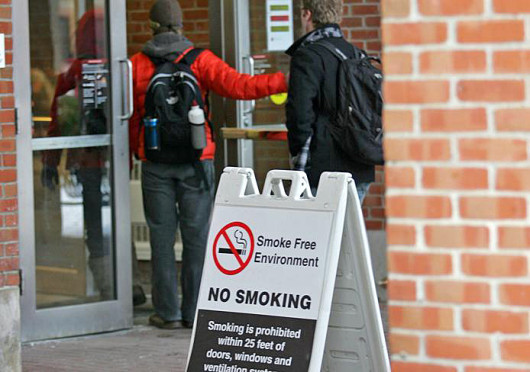
OSU is planning to enforce a campus-wide tobacco ban in January 2014 that will prohibit the use of cigarettes and other products on campus. Credit: Lantern file photo
If a campus-wide ban is created but not enforced, did it happen at all?
Technically, the looming Ohio State tobacco-ban has been implemented in its education stage but not enforced on campus all semester, but it’s not uncommon to see smokers casually lighting up in buildings’ loading docks. Technically, when the ban is expected to be enforced in January 2014, rule-breakers won’t be held to strict and immediate repercussions for smoking between classes or on the walk to their car.
So, technically, does it matter?
Based on the reporting The Lantern has done over the past year, we think not.
In theory, the campus-wide smoking ban is a great idea. Smoking is bad for the health of smokers and others around them, so naturally it makes sense for a university like OSU, with a world-renowned Medical Center and cutting edge research, to be against it.
In theory, it’s understandable why some students or staff would be upset about being forced to stop smoking on campus. No one likes an inconvenient rule change, whether the university has the right to make that decision or not. Which it does.
Also in theory, it would be a ridiculous use of resources to have our university police officers stopping students on the Oval and asking them to put out their cigs, or showing up in the back row of lecture halls to tell students they can’t use chewing tobacco.
So in reality, what should the smoking ban do? The answer is nothing, which is demonstrated by the lack of serious enforcement behind the plan.
The tobacco-ban is all bark, no bite.
In July 2012, the Ohio Board of Regents, an Ohio governing education body, recommended all Ohio public universities implement a tobacco ban. OSU followed suit with its own ban that was initially expected to be launched in August, according to a university-wide email sent by former OSU President E. Gordon Gee.
But August rolled around and the ban was pushed back.
Back in March at an editorial board interview with The Lantern, Gee discussed the ban which, at the time, would be recommended for adoption by the Board of Trustees the next month.
“We are recommending that we move to a tobacco-free campus. I think that’s very important,” Gee said. “We have a tobacco-free medical center and now we want to have a tobacco-free campus.”
At the time, Gee did not specify the methods the university would use to enforce it.
Until very recently, no one had.
In September, The Lantern reported the smoking ban would not be enforced by university police but instead, reported offenders would be held accountable to OSU Human Resources and the Student Code of Conduct.
Punishments for students could range from letters of reprimand, which are written letters issued because of a student’s misconduct, to dismissal.
Anyone can report a violation, but the question is who would take the time to do such a thing?
For this we reference the bystander effect, a psychological phenomenon in which individuals do not offer help to a person in need if there are other people around who they assume will do it instead.
Except in this case there is no victim, it’s a smoker lurking behind the Ohio Union, and 911 isn’t involved. It’s instead the heavy hand of an OSU crackdown.
Would you call this one in? Our guess is no.
If OSU wants a ban to be taken seriously, then the university should focus on creating rules it knows it can and will enforce.


